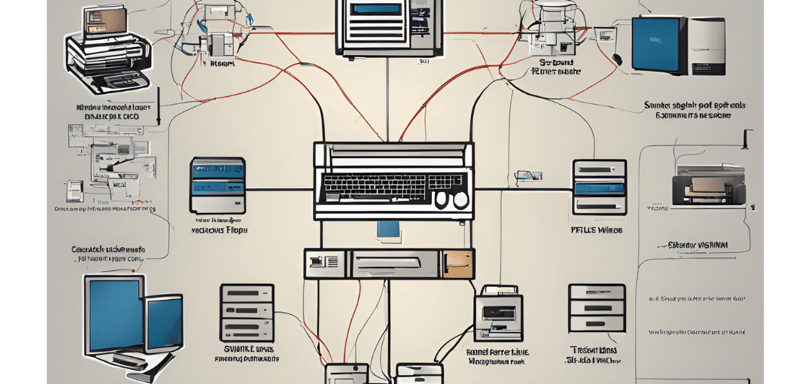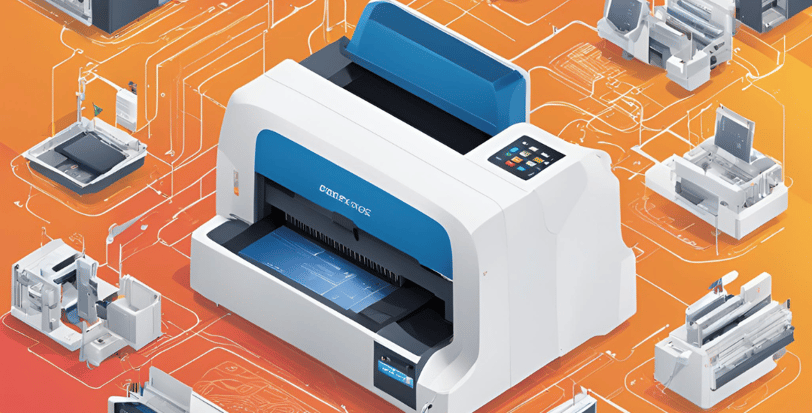Best Practices for Maintaining Your Network Printer - Expert Tips
Discover the best practices for maintaining your network printer. Learn how to improve print quality, extend the lifespan, and troubleshoot common issues with our expert tips.
Praveen Kumar - Canon Printer Specialist
12/12/20249 min read


Network Printing: What You Need to Know
Are you tired of dealing with multiple printers in your office or home that can’t communicate with each other? Do you want to simplify printing tasks and save time? Network printing may be the solution you’re looking for!
Many businesses and home offices still rely on local printers connected to individual devices, which can be inefficient, costly, and cumbersome. You have to manually switch between printers, deal with limited printer access, and sometimes run into issues with compatibility and connectivity.
If you’ve been struggling with managing printers on your own, feeling frustrated with endless wires or connectivity problems, or worrying about the added expenses of printer maintenance for each device, you’re not alone. The complexity of using multiple printers in one space can lead to unnecessary hassle, wasted time, and confusion.
Network printing allows you to connect multiple printers to one central network, giving you easy access from any device in your office or home. This streamlined solution improves productivity, reduces costs, and enhances the overall printing experience.
What is a Network Printer?
A network printer is a printer that is connected to a network, allowing multiple devices to access and print from it. It can connect either through a wired Ethernet connection or wirelessly via Wi-Fi. It allows multiple devices such as computers, smartphones, and tablets to access the printer over the network, without needing to be directly connected to it via cables.
These printers can be shared by several users within the same local network, making them ideal for both small offices and larger enterprises. Network printers eliminate the need for having individual printers connected to each computer, thus optimizing space, reducing clutter, and cutting down on costs associated with maintaining multiple devices.
By using a network printer, your devices can send print jobs over the network to the printer, regardless of where the device is located within the network. This provides flexibility and convenience that local printers can’t offer.
How Does a Network Printer Work?
Understanding how network printers work is essential to setting them up correctly and troubleshooting any issues you might encounter.
Connection to Network: A network printer can connect to your network via Ethernet or Wi-Fi. Once it is connected, it can communicate with other devices on the same network.
Assigning an IP Address: For a network printer to function, it needs an IP address. This address ensures that data from your device can be sent to the right printer. Depending on your network setup, the IP address can be static (manually assigned) or dynamic (automatically assigned by the router).
Print Job Transmission: When you send a document to print, the data is transmitted over the network to the printer’s IP address. The printer then processes the document and prints it according to the settings chosen.
Device Compatibility: Devices such as laptops, desktops, and mobile phones can all connect to a network printer as long as they are on the same network. This makes the printer accessible to multiple users at once.
Network printers can be used in both home and business environments, and the key benefits of having a network printer include increased accessibility, better resource management, and the ability to enable printing from any device linked to the network.
Benefits of Network Printing Over Local Printing
Network printing offers several distinct advantages over local printing setups. Here are the key benefits:
Cost Savings: One of the major benefits of using network printers is the cost savings. Instead of buying and maintaining separate printers for each computer or workstation, you can share a single printer across multiple devices. This reduces the need for multiple ink cartridges, paper supplies, and maintenance costs for several machines.
Increased Productivity: With network printing, you no longer need to manually move documents from one device to another to print them. Whether you’re working from a laptop, smartphone, or desktop, you can send print jobs to the same printer from any device on the network.
Centralized Management: With multiple devices connected to the same printer, managing printer settings, updates, and security is much easier. Network printers often come with administrative software that allows you to monitor printer status, manage print queues, and perform diagnostics all in one place.
Flexibility: Network printers provide the flexibility to print from anywhere within the network range. This is particularly beneficial in office settings, where employees can send print jobs from their desks or meeting rooms without needing to be directly connected to the printer.
Simplified Setup: Once a network printer is set up, it can be shared with all devices connected to the network. There’s no need for additional installations or separate drivers for each user, which simplifies the setup process for new users or devices.
Local vs. Network Printers: Which is Right for You?
When deciding between local and network printers, it’s important to consider the unique needs of your home or business setup.
Local Printers: These printers are directly connected to a single device, such as a computer or laptop, using a USB or parallel port. Local printers are typically cheaper and easier to set up but have limitations in terms of sharing capabilities. They are most suitable for individual use or small workspaces where only one person needs access to the printer.
Network Printers: Network printers, on the other hand, are ideal for businesses, offices, or households with multiple devices that need access to a single printer. They are more flexible and can handle multiple print jobs simultaneously, making them a more efficient choice for environments with several users.
In choosing between the two, you should ask yourself:
Do I need multiple devices to access the printer at the same time?
Am I looking to reduce clutter and costs by eliminating the need for multiple printers?
Is flexibility and ease of management important for my workspace?
If the answer is yes to any of these questions, a network printer will likely be the better option.
Setting Up a Network Printer: Step-by-Step Guide
Setting up a network printer may seem complicated at first, but with the right instructions, it’s a straightforward process. Here’s how you can get started:
Choose the Right Printer: First, ensure that the printer you purchase is compatible with network printing. Most modern printers support either Ethernet (wired) or Wi-Fi (wireless) connections.
Connect the Printer to Your Network:
Wired Setup: Plug the printer’s Ethernet cable into a router or network switch. This will assign the printer an IP address automatically if you’re using DHCP (Dynamic Host Configuration Protocol).
Wireless Setup: Use the printer’s control panel to connect it to your Wi-Fi network. Enter your network credentials (SSID and password) when prompted, and the printer will join the network.
Install Printer Drivers on Your Devices: After the printer is connected, install the necessary drivers on your computers or mobile devices. This enables your devices to establish communication with the printer.
Assign a Static IP Address (Optional): For a more reliable connection, you may want to assign a static IP address to the printer. This ensures that the printer always has the same address on the network, preventing connection issues.
Test the Printer: Finally, test the printer by sending a print job from one of your devices. Ensure that it prints correctly and that all devices connected to the network can access it.


Common Issues with Network Printers and How to Troubleshoot Them
Despite the many benefits of network printing, users sometimes face challenges with setup, connectivity, and performance. Below, we’ll explore some of the most common issues associated with network printers and provide solutions to help you troubleshoot these problems.
1. Printer Not Found on the Network
Problem: One of the most frequent issues is when your computer or device can't find the printer on the network, even though it’s connected.
Possible Causes:
The printer isn’t connected to the correct network (Wi-Fi or Ethernet).
The printer’s IP address may have changed or wasn’t assigned properly.
The network configuration is incorrect.
Solution:
Verify Network Connection: Make sure the printer is connected to the correct network. Check if it’s wired or wireless, and ensure the router is functioning properly.
Check the Printer’s IP Address: If the printer uses a dynamic IP address, it may change after a reboot. Access the printer’s control panel to find the current IP address, or assign a static IP to prevent future issues.
Ping the Printer: From your computer, try pinging the printer's IP address. If it doesn’t respond, there’s likely a connectivity issue that needs addressing.
Restart Devices: Reboot the printer, router, and computer to resolve any temporary network glitches.
2. Printer Offline Error
Problem: Sometimes, a network printer will show as "offline" on your device, even when it is physically connected and powered on.
Possible Causes:
Printer driver or software issues.
The printer might have been disconnected from the network.
Print queue issues.
Solution:
Check Printer Status: Ensure that the printer is turned on and that the correct network connection (Wi-Fi or Ethernet) is active.
Set Printer to Online Mode: In your device’s control panel, go to "Printers and Scanners" and check if the printer is marked as offline. If it is, change the setting to online.
Clear Print Queue: If there are stalled print jobs, they could cause the printer to go offline. Clear the print queue from your computer and restart the printer.
Reinstall Printer Drivers: If the offline issue persists, try uninstalling and reinstalling the printer drivers.
3. Slow Printing Speed
Problem: Network printers can sometimes print slowly, especially when handling large documents or multiple print jobs.
Possible Causes:
Network congestion or weak Wi-Fi signals.
The printer is connected to an overloaded or slow network.
Insufficient printer memory for large print jobs.
Solution:
Check Network Speed: Make sure your network is fast enough to handle the print jobs, especially if you have multiple devices using the same network simultaneously.
Use a Wired Connection: If you are using a wireless connection, try switching to a wired Ethernet connection for a more stable and faster printing experience.
Reduce Print Quality: Sometimes, high-quality print settings can cause delays. Adjust the printer settings to lower the resolution or print in draft mode for faster results.
Upgrade Printer Memory: If you frequently print large files, consider upgrading the printer’s memory (if possible) to enhance performance.
4. Print Jobs Stuck in the Print Queue
Problem: Occasionally, print jobs can get stuck in the print queue, preventing any new jobs from being processed.
Possible Causes:
Corrupted print jobs.
Software or driver issues.
Solution:
Cancel Stuck Jobs: Open the print queue and manually cancel any jobs that are stuck. Restart the printer to clear any issues.
Restart the Print Spooler: On your computer, restart the print spooler service, which manages print jobs. This can often resolve issues with stuck jobs.
Update Drivers: Outdated printer drivers can cause errors with the print queue. Visit the manufacturer's website to download the most up-to-date version of the printer driver.
5. Poor Print Quality
Problem: Printouts may appear faded, streaky, or have missing sections.
Possible Causes:
Low ink or toner levels.
Dirty print heads or nozzles.
Incorrect print settings or paper type.
Solution:
Check Ink or Toner Levels: Ensure that ink or toner cartridges are not low. Replace them if necessary.
Clean Print Heads: Many printers have a built-in cleaning function to clear clogged print heads. Use the printer's control panel or software to perform this.
Adjust Print Settings: Ensure that the paper type and print quality settings match your printing needs. Printing on plain paper with high-quality settings can result in poor quality.
Choose the Right Paper: Using the wrong type or size of paper can result in poor print quality.
6. Printer Not Responding to Print Jobs
Problem: Sometimes, the printer won’t respond to print jobs, even though it is online and connected to the network.
Possible Causes:
Printer is overloaded with tasks or is stuck.
Incorrect configuration or software issues.
The device isn’t properly linked to the printer.
Solution:
Restart the Printer: Turn the printer off and on again to clear any errors or tasks that may have caused it to freeze.
Check Device Connection: Ensure that the computer or mobile device sending the print job is properly connected to the same network as the printer.
Reconfigure Printer: If there are ongoing issues with printer recognition, remove and add the printer again in the "Devices and Printers" section on your computer.
7. Wireless Printing Issues
Problem: Wireless printers are prone to connectivity problems, especially if the Wi-Fi signal is weak or unstable.
Possible Causes:
Weak or unstable Wi-Fi connection.
Network interference from other devices.
Incorrect printer network settings.
Solution:
Move Printer Closer to Router: If the printer is too far from the Wi-Fi router, try moving it closer to improve the signal strength.
Check for Interference: Devices such as microwaves and cordless phones can interfere with Wi-Fi signals. Ensure that the printer is placed in an area with minimal interference.
Reconnect Printer to Wi-Fi: If the printer loses its Wi-Fi connection, reconnect it to the network using the printer’s control panel or software.
Conclusion: Ensuring Smooth Network Printing
While network printers can sometimes present challenges, the benefits they offer in terms of cost savings, convenience, and productivity far outweigh the occasional hiccups. By understanding common issues and knowing how to troubleshoot them, you can ensure a smoother, more efficient printing experience.
Regular maintenance, proper network setup, and timely troubleshooting can help you get the most out of your network printer, keeping your printing tasks running smoothly. If you encounter issues that you can’t solve on your own, don’t hesitate to contact support for further assistance.
Insights
Explore the latest in printer technology and tips.
Resources
Support
contact@bestprintershop.com
+918920029543
© 2024 BestPrinterShop . All rights reserved.
